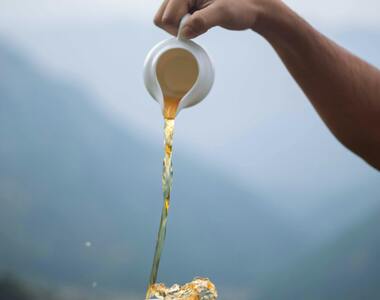
What’s the first thing that comes to your mind when you think of scented candles? Romance? Relaxation? Engagement proposals? Warm baths and wine glasses? Scented candles are perfect for any of these occasions. You can find them in home decor stores, supermarkets, and online gift shops. But, maybe, you don’t want to visit the store, you want to make them for yourself, gift a loved one, or start a business. That’s great because this article will teach you how to make scented candles.
Knowing Your Scents
What kind of mood do you want to create and how do you want to feel? These determine the kind of scents you should go for. For example, fresh and flowery notes will put you in a light, refreshing mood, while woody notes will create a sensual, relaxing mood.
However, making a candle is more than throwing fragrance oil in melted wax. It is important to create a harmony of fragrance notes that leave a lasting, distinct smell. Scents are divided into notes; top, middle, and bottom notes.
- Top notes, also called head notes, are the scents you pick immediately. They’re the first scents you pick when you smell a candle you want to buy. And even when burning, they remain at the top. This is because they are made up of molecules that evaporate quickly. Fresh aromatic, citrus, gourmand and aquatic scents fall into this category.
- Middle notes, also called heart notes, are the scents that emerge as the top notes evaporate. They are warm, gentle to your olfactory senses, and sweet-smelling. When buying candles, these are the scents you perceive when you take a second breath. Floral, fruity, gourmand and spicy scents form the middle notes.
- Bottom notes, also called base notes, are the strongest notes. They last more than any other fragrance notes, and solidify your candle scent. When burning your candle, they are the dominant scents that fill the room and take a while to leave after you turn it off. This is because they are rich and have larger molecules that evaporate slowly. Woody, balsamic, and exotic scents form the base notes.
Fragrance Categories
Fragrances are either fresh, warm, or gourmand. There are subcategories in the fresh and warm notes, and some notes fit into more than one subcategory.
Fresh Notes
As the name implies, fresh notes carry a sense of freshness and vitality. They make you feel light and easy! Fresh notes are either fresh or floral.
In the Fresh category we have:
Fresh Notes
- Citrus: Grapefruit, lime, orange, bergamot, and lemon.
- Aquatic: Sea salt, rain, dew, and ocean.
- Green: Mint, green tea, grass, bamboo, and tomato leaf.
- Fruity: Coconut, cucumber, apple, pear, cranberry, and almond.
Floral Notes
- Soft Floral: Carnation, iris, linen.
- Floral: Lily, jasmine, rose, lilac, peony, violet, lavender.
- Fruity: Pineapple, mango, peach, raspberry.
Warm Notes
Think comfort and intimacy, and you have warm notes. These scents are endearing, cozy, rich, and heavy. They mostly form the middle and bottom notes, and feel like a cozy sweet-smelling blanket.
In the Warm category we have:
- Earthy: Cinnamon, cloves, musk, incense, vetiver.
- Woody: Patchouli, sandalwood, vetiver, teakwood, pine, oakmoss, amber.
- Dry Woody: Leather, tobacco, oud, incense.
- Aromatic: Rosemary, sage, eucalyptus, thyme.
Gourmand Notes
You know those candles that make you think of cake? Those ones that smell so sweet, almost like cookies and ice cream? Those are gourmand notes. They are edible or dessert-scenting notes and leave you feeling like you walked into a cake or pastry shop. Some gourmand notes are vanilla, caramel, chocolate, candy, and warm sugar. These scents fit perfectly as top or middle notes.
These categories don’t cover all the scents in the world. In fact, scientists are still creating more scents to add to the existing ones. However, a proper combination of these scents will create signature scented candles you will love!
Important Things To Note About Fragrance Notes
- The mood you want to create should guide the scents you pick and how you layer them.
- Fragrance oils have different strengths. Using a fragrance oil with a weak scent can result in a poorly scented candle. Try testing the oils before mixing them with the wax.
- Floral, fruity and woody scents produce the sweetest and deepest scent throws for candles.
Knowing Your Wax
I’ll skip the textbook definition of a wax and tell you this: your wax is your base. It is the foundation of candle making. To know how to make scented candles, you must know what wax to use. Wax exists in two forms: solid, when cold and unlit; and, liquid, when melted and lit.
1. Paraffin Wax
Also known as mineral wax, this crude oil by-product is very popular for holding scents, and is particularly popular with top candle brands. It is also highly recommended for beginners, as it cures within two days, burns fast, and holds scents more than other waxes. The melting point of paraffin wax is 38°C (100° F), and its cure time is within 3-5 days.
2. Soy Wax
Soy wax is a vegetable wax derived from soybean oil. It is more environment-friendly than paraffin wax, burns slower and cleaner, and is cheaper than coconut wax or beeswax. Soy wax is harder to use than paraffin wax, and has a subtle hot and cold throw. In recent times, it’s mixed with coconut, paraffin, and beeswax to create soy blends. The melting point of soy wax is 51°C (124° F), and its cure time is 10 – 15 days.
3. Coconut Wax
Coconut wax is the best eco-friendly wax. It burns slow, has an excellent hot and cold throw, and an alluring creamy white colour. It is, however, the most expensive of all waxes because of its quality. The melting point of coconut wax is 44°C – 48°C (111.2 – 118.4° F), and its cure time is 7 – 14 days.
4. Canola Wax
Also known as rapeseed wax, it is sourced from a bright yellow plant from the mustard family. It is more popular in Europe, and is sustainable and renewable. It has great fragrance retention, burns slow, and has an excellent scent throw. The melting point of canola wax is 35°C (95° F), and its cure time is 3 – 7 days.
Important Things To Note About Candle Wax
- The kind of wax you use determines your candle’s hot or cold throw.
- Each wax melts at different temperatures. Knowing the right temperature will guide your process.
- Paraffin wax is perfect for beginners, cures faster than all waxes, and bonds more easily than others.
- Coconut wax, though expensive, is currently the best wax as it burns better, produces good hot and cold throws, and has a beautiful colour.
Tools For Scented Candles
- Melting pot
- Measuring scale
- Thermometer
- Measuring pipette
- Wicks and wick holders
- Candlewick trimmer
- Wax
- Fragrance oils
- Candle jars
- Candlewick stickers
- Pouring pitcher
- Candle stirring spoon
- Aluminum foil or brown wrapping paper or clean linen sheet.
How To Make Scented Candles

- Clean your jars and prepare your environment. Place aluminum foil or brown paper or a clean linen shit in the area you will be making your candles.
- Put the candle wick stickers and candle wick in the jars. Use a wick holder to keep the wicks straight and steady.
- Put the desired quantity of wax in your melting point and measure it with your thermometer. To know the melting points of all types of wax, read the ‘Knowing Your Wax’ section.
- With the measuring pipette, add your essential oils first, and then your fragrance oils, layering them from the bottom notes to top notes. Stir for 3-5 minutes for the molecules to blend well.
- If your melting pot isn’t shaped like a jug, pour the wax into the pouring pitcher and stir again for two minutes.
- Carefully pour the scented wax into your jars and allow them to cool.
- Remove the foil or linen and use a warm towel to clean up any wax that may have spilled outside the area. Soak your tools in hot water to melt the wax and clean easily.
- Allow your candles to cure within their recommended period.
How To Package Scented Candles
Making candles is one thing and packaging them is another. Whether as a gift or a product for sale, packaging adds the perfect finishing touch and elevates your candles. You can:
- Use a colourful wrapping paper and transparent sellotape or glue.
- Use a wrapping paper and a ribbon at the top.
- Create small DIY boxes and add ribbon pins on them.
- Paint your candle jars with flowers or other cute designs and use a fancy ribbon for the lid.
Remember, the packaging design is up to you. These are mere suggestions, but whichever way you package it, make sure it is clean, fancy, and portrays your style.
Conclusion
Candle making is more science than art. It can be likened to baking. So, while this article may not be an exhaustive step-by-step guide on how to make yours, it provides the basic steps, tools, and things you need to know about how to make scented candles.
Shop our scented candles on BuyAfricaMade and read more related articles here!








